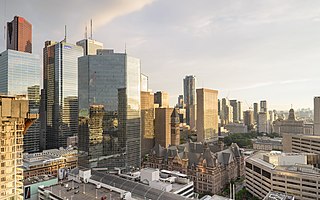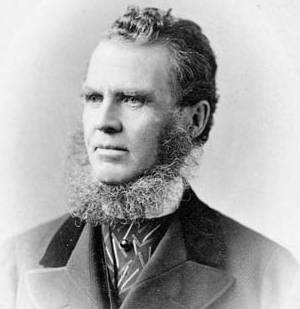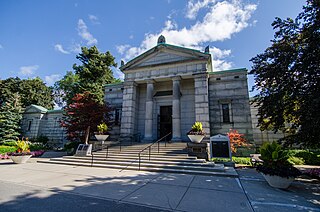
Mount Pleasant Cemetery is a cemetery located in Toronto, Ontario, Canada. The cemetery was opened in November 1876, and is located north of Moore Park, a neighbourhood of Toronto. The cemetery has miles of drives and walking paths, interspersed with fountains, statues, botanical gardens, and rare and distinct trees, originally laid out by German-born landscape architect Henry Adolph Engelhardt, inspired by the European and American garden cemeteries of the 19th century, and with influences from Mount Auburn Cemetery in Boston.

The Fairmont Royal York, formerly and commonly known as the Royal York, is a large historic luxury hotel in Toronto, Ontario, Canada. Located along Front Street West, the hotel is situated at the southern end of the Financial District, in Downtown Toronto. The Royal York was designed by Ross and Macdonald, in association with Sproatt and Rolph, and built by the Canadian Pacific Railway company. The hotel is presently managed by Fairmont Hotels and Resorts.

The Bishop Strachan School (BSS) is an Anglican day and boarding school for girls in Toronto, Ontario, Canada. The school has approximately 900 students, including 80 boarding students, ranging from Junior Kindergarten to Grade 12. The School is named after John Strachan, the first Anglican bishop of Toronto, and was founded by John Langtry in 1867. The founders' intention was to educate girls to be leaders.
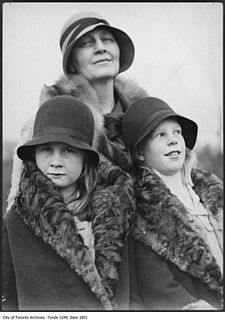
Flora McCrea Eaton, Lady Eaton was the wife of Toronto department store president and heir Sir John Craig Eaton.

The Canada Life Building is a historic office building in Toronto, Ontario, Canada. The fifteen-floor Beaux Arts building was built by Sproatt & Rolph and stands at 285 feet (87 m), 321 feet (97.8 m) including its weather beacon.

College Park is a shopping mall, residential and office complex on the southwest corner of Yonge Street and College Street in Toronto, Ontario, Canada.
Ross and Macdonald was one of Canada's most notable architecture firms in the early 20th century. Based in Montreal, Quebec, the firm originally operated as a partnership between George Allen Ross and David MacFarlane from 1907 to 1912. MacFarlane withdrew from the firm in 1912, and Robert Henry Macdonald became a partner.

Châteauesque is a revival architectural style based on the French Renaissance architecture of the monumental French country houses (châteaux) built in the Loire Valley from the late fifteenth century to the early seventeenth century.

The Carlu is an historic event space in Toronto, Ontario, Canada. Opened in 1930 and known as the eponymous "Eaton's Seventh Floor", the venue was restored and reopened in 2003, renamed for its original architect. The Carlu is one of Toronto's best examples of Art Moderne architecture. The venue is owned by restaurant firm Oliver & Bonacini.
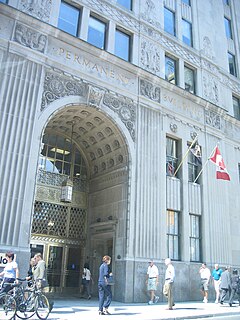
Canada Permanent Trust Building in Toronto, Ontario, Canada is an Art Deco structure built between 1928 and 1930. It was designed by the architect Henry Sproatt. The 18-floor office building is located at 320 Bay Street and was built by F. Hilton Wilkes.

The Royal Canadian Yacht Club (RCYC) is a private yacht club in Toronto, Ontario, Canada. Founded in 1852, it is one of the world’s older and larger yacht clubs. Its summer home is on a trio of islands in the Toronto Islands. In 2014, the club had approximately 4700 members, about 450 yachts and a number of dinghies, principally International 14s. Its winter home since 1980 has been a purpose-built clubhouse located at 141 St. George Street in Toronto, which includes facilities for sports and social activities.

The New Club is a private social club in the New Town area of Edinburgh, Scotland. Founded in 1787, it is Scotland's oldest club. The club occupied premises on St Andrew Square from 1809 until 1837, when it moved to purpose-built rooms on Princes Street. The 1837 building was replaced with a modern building to a design by Reiach and Hall, which is protected as a category A listed building. Ladies were admitted in 1970, and offered full membership from 2010. Prince Philip, Duke of Edinburgh has been the Patron of the Club since 1952. The only stated requirements for membership are that a candidate is over 18 and is "clubbable".

The Penn Club of New York is a private club located in Midtown Manhattan, within New York City, New York, United States. Its membership is restricted almost entirely to students, alumni, and faculty of the University of Pennsylvania in Philadelphia, Pennsylvania. Its clubhouse is a fourteen-story building located on West 44th Street between Fifth Avenue and Sixth Avenue. Originally occupied by the Yale Club of New York City, the building is registered on the National Register of Historic Places.

The Granite Club is a private social and athletic club in Toronto, Ontario, Canada. Founded in 1875, it has a long history of sports competition. It is located at 2350 Bayview Avenue, north of midtown Toronto.
The New Cavendish Club was a London private members' club, run along the lines of a traditional gentlemen's club, although it had been founded as a Ladies-only club. It was located at 44-48 Great Cumberland Place in the Marylebone district.
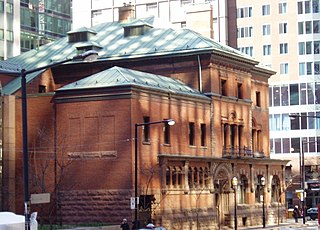
The Toronto Club is a private business and social club in Toronto, Ontario, Canada. Founded in 1837, it is the oldest private club in Canada, and third oldest in North America. The clubhouse, located at 107 Wellington Street West, was designed by Frank Darling and S. George Curry in 1888, and opened in 1889. The building had additions and alterations between 1911-1912 by Darling and Pearson. The building mixes different architectural styles and marks an important transition in Darling's career. The clubhouse was recognized as a heritage property by the City of Toronto in 1984 and by the Ontario Heritage Foundation in 2002.

The Heintzman House, also known as Sunnyside Manor Farm, is one of the oldest buildings in Thornhill-Markham, Ontario, and has one of the most interesting histories of any building in the area.
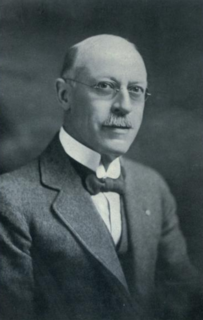
Alexander Frank Wickson was a prominent Toronto architect who was responsible for the design of numerous buildings, including Timothy Eaton Memorial Church, the IOOF Hall (Toronto) and the "Ardwold" mansion for the Eaton family. He was president of the Ontario Association of Architects in 1900 and of the Royal Architectural Institute of Canada from 1918 to 1920.


